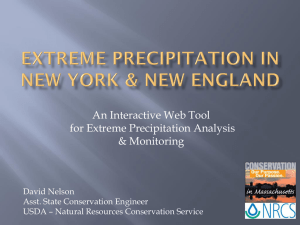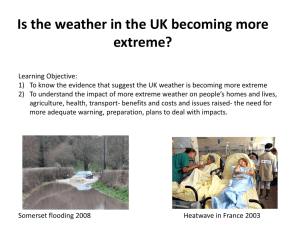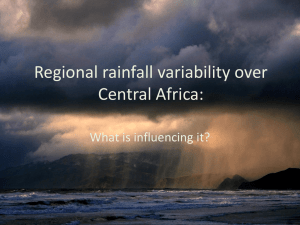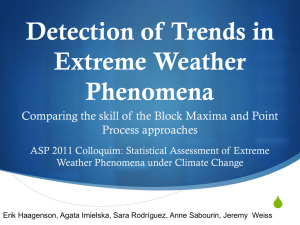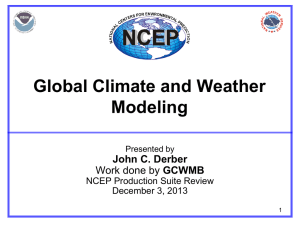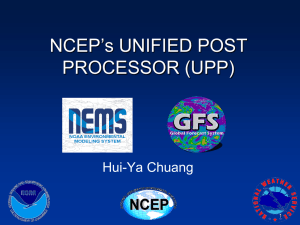PPT
advertisement
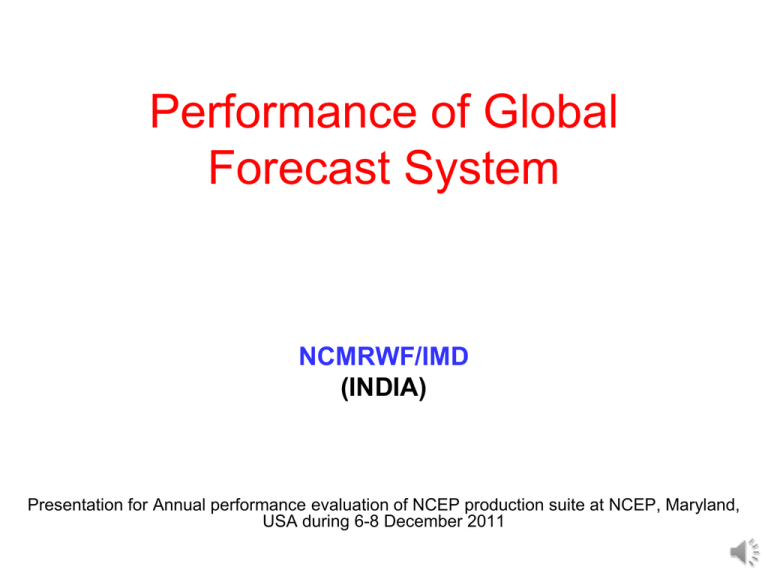
Performance of Global Forecast System NCMRWF/IMD (INDIA) Presentation for Annual performance evaluation of NCEP production suite at NCEP, Maryland, USA during 6-8 December 2011 Care-takers • NCMRWF • Data/monitoring: Munmun Das Gupta, Indira Rani • Analysis : V S Prasad • Model/post : Saji Mohandas • Verification : Gopal Iyengar • GEFS : E N Rajagopal • IMD • Data/monitoring: S D Kotal • Analysis/Model/Verfication : V R Durai • Co-ordinator : S.K.Roy Bhowmik Numerical Weather Prediction System of NCMRWF Data Global Observations Reception SURFACE from land stations GTS RTH, IMD SHIP Global Data Assimilation Observation quality checks & monitoring Upper Air RSRW/ PIBAL Aircraft Satellite NKN ISRO (MT) NCMRWF OBSERVATION PROCESSING 45mbps High Resolution Satellite Obsn NKN Internet (FTP) NESDIS proposed dedicated link EUMETSAT Users Global Model T574L64 10day FCST IMD INCOIS BUOY 24x7 Forecast Models Global Analysis (GSI) Initial state Global Forecast Model ( 9hr Fcst – first guess ) 4 times a day for 00,06,12,18 UTC Visualisation NKN Meso-scale Data Assimilation & Model Statistical Interpolation Model (location specific FCST) once in a day for 00 UTC Other sectors GFS Models (NCMRWF) – Current status Model Version Horizontal Forecast Resolution Length Performance GFS T382L64 GFS version 9.0.1 ~35km 168 Hrs (3hr data cutoff) 4 min. for 24 hr forecast (IBMP6 16 nodes) GFS T574L64 GFS version 9.0.1 ~23km 240 Hrs (5hr data cutoff) 9 min. for 24 hr forecast (IBMP6 16 nodes) GEFS T190L28 Latest version 20 members ~70km 240 Hrs (Not operational) 6 min. For 24 hr forecast (IBM-P6 8 nodes) High Performance Computing Systems HPC Connectivit y No of Processors available Per node memory Processor speed IBM Infini Band Power 6 38x32 (NCMRWF) 24x32 (IMD) 4x32 GB 4.7 Gflops Recent developments in NCMRWF GFS system Implementation of the T382L64 GFS from May 2010 (latest versions of upgraded model and GSI) Assimilation of additional data in T382L64 GFS The Advanced Microwave Scanning Radiometer - Earth Observing System (AMSR-E) winds Rainfall rates (TRMM, SSMI) NOAA19 radiances Atmospheric Infrared Sounder (AIRS) radiances GPSRO (COSMIC) Implementation of the T574L64 GFS from mid-November, 2010 (July 2010 Version) Implementation of latest NCEP version of T574L64 (from June, 2011) Time line - NCMRWF GFS The T382L64 GFS was implemented in May 2010. The T574L64 GFS was first implemented in November 2010. T382L64 performance was evaluated during Monsoon 2010 and was found to marginally better than the T254L64 GFS. T254L64 stopped. T574L64 performance was evaluated during NovemberDecember 2010 and was found to better than the T382L64 GFS. T382L64 model was run parallel to T574L64 for Monsoon 2011 The latest version of the NCEP T574L64 GFS was implemented in May 2011 and found to be better than T382L64 system T382L64 run stopped from November 2011 End-to-end T574L64 GFS system was transferred to IMD on 15 November, 2011 Physical Parameterization schemes in T382L64 and T574L64 Physics T382L64 T574L64 Surface Fluxes Monin-Obukhov similarity Monin-Obukhov similarity Turbulent Diffusion Non-local Closure scheme (Hong and Pan (1996) Non-local Closure scheme (Lock et al., 2000) SW Radiation Based on Hou et al. 2002 –no aeroslos – invoked hourly Rapid Radiative Transfer Model (RRTM2) (Mlawer et al. 1997; Mlawer and Clough, 1998)- aerosols included– invoked hourly LW Radiation Rapid Radiative Transfer Model (RRTM) (Mlawer et al. 1997). –no aerosols- invoked 3 hourly Rapid Radiative Transfer Model (RRTM1) (Mlawer and Clough 1997;1998). –aerosols includedinvoked hourly Deep Convection SAS convection (Pan and Wu (1994) SAS convection (Han and Pan, 2006) Shallow Convection Shallow convection Following Tiedtke (1983) Mass flux scheme (Han and Pan, 2010) Large Scale Condensation Large Scale Precipitation (Zhao and Carr ,1997; Sundqvist et al., 1989) Large Scale Precipitation (Zhao and Carr ,1997; Sundqvist et al., 1989) Cloud Generation Based on Xu and Randall (1996) Based on Xu and Randall (1996) Rainfall Evaporation Kessler (1969) Kessler (1969) Land Surface Processes NOAH LSM with 4 soil levels for temperature & moisture (Ek et al., 2003) NOAH LSM with 4 soil levels for temperature & moisture (Ek et al., 2003) Air-Sea Interaction Roughness length by Charnock (1955)Observed SST,Thermal roughness over the ocean is based on Zeng et al., (1998).3-layer Thermodynamic Sea-ice model (Winton, 2000) Roughness length by Charnock (1955), Observed SST, Thermal roughness over the ocean is based on Zeng et al., (1998). 3-layer Thermodynamic Sea-ice model (Winton, 2000) Gravity Wave Drag & mountain blocking Based on Alpert et al. (1988) Lott and Miller (1997), Kim and Arakawa (1995), Alpert et al., (1996) Vertical Advection Explicit Flux-Limited Positive-Definite Scheme (Yang et al., 2009) Differences of the T574L64 GSI Data Assimilation system compared to T382L64 New observations assimilated Improvements in Data Assimilation system Inclusion of METOP IASI (Infrared Atmospheric Sounding Interferometer) data Use of variational qc Reduction of number of AIRS (Atmospheric Infrared Sounder) water vapor channels used Addition of background error covariance input file Assimilating tropical storm pseudo sea-level pressure observations, Flow dependent reweighting of background error variances NOAA-19 HIRS/4 (High Resolution Infrared Radiation Sounder) and AMSU-a (Advanced Microwave Sounding Unit) brightness temperature, Use of new version and coefficients for community radiative transfer model (CRTM -2.02 ) NOAA-18 SBUV/2, (Solar Backscatter Ultraviolet Spectral Radiometer) Ozone , EUMETSAT-9 atmospheric motion vectors. Improved Tropical Cyclone Relocation Using uniform thinning mesh for brightness temperature data. Change in land/snow/ice skin temperature variance Improving assimilation of GPS radial occultation data. RE-tuned observation errors. ASCAT (Advanced Scatterometer) winds included Korean AMDAR data and more number of Aircraft Reports European Wind profiler data Types of observations Assimilated in GFS Observation category Name of Observation. Surface Land surface, Mobile, Ship, Buoy (SYNOPs) Upper air TEMP (land and marine), PILOT (land and marine), Dropsonde, Wind profiler Aircraft AIREP, AMDAR, TAMDAR, ACARS Atmospheric Motion Vectors from AMV from Meteosat-7, Meteosat-9, GOES-11, Geo-Stationary Satellites GOES-13, MTSAT-1R, MODIS (TERRA and AQUA), Scatterometer winds ASCAT winds from METOP-A satellite, NESDIS / POES ATOVS Sounding radiance data 1bamua, 1bamub, 1bmhs,1bhirs3, 1bhirs4 Satellite derived Ozone data NESDIS/POES, METOP-2 and AURA orbital ozone data Precipitation Rates NASA/TRMM (Tropical Rainfall Measuring Mission) and SSM/I precip. rates Bending angles from GPSRO Atmospheric profiles from radio occultation data using GPS satellites NASA/AQUA AIRS & METOP/ IASI brightness temperature data IASI,AIRS,AMSR-E brightness temperatures Count of different types of observations over Indian Region (received at NCMRWF at 00 UTC from 1 to 25 of months June, July, August, and September 2011) Observation Type June July August September SYNOP 143 139 142 136 RS/RW 33 33 37 39 PILOT 31 25 22 23 AWS 544 719 552 690 ARG 195 424 308 357 BUOY 10 10 11 10 Data Reception: NCMRWF vs ECMWF (S-W Monsoon, 2011) (Average number of observations received in 24 hours ) RED COLOUR INDICATES LESS DATA ; BLUE COLOUR INDICATES COMPARABLE DATA June July August NCMRWF ECMWF NCMRWF ECMWF NCMRWF ECMWF SYNOP/SHIP Pressure BUOY (Drifter) 46,118 78,390 56,734 78,481 57,607 78,574 10,715 13,953 13,882 13,879 13,752 13,531 TEMP 500 hPa Geopotential TEMP/PILOT 300 hPa Wind AIRCRAFT winds (300-150 hPa) AMV winds (400-150 hPa) AMV winds (1000-700 hPa) 1,088 1,286 1,271 1,286 1,320 1,336 1,098 1,434 1,300 1,429 1,349 1,490 58,412 1,04,987 72,842 1,02,562 72,685 1,03,059 2,00,283 10,06,280 2,55,690 9,78,269 2,43,282 9,45,691 1,28,786 8,53,193 8,91,204 1,52,905 8,21,724 1,54,724 Vertical Profile of T574L64 (Dotted Line) and T382L64 (Bold Line) Analyses (Black) and First Guess (Red) Vector Wind Fits (Bias and RMSE) to RAOBS over Global for JJAS, 2011. The Right Panel graph gives the observation data counts over the region used for the comparison. Vertical Profile of T574L64 (Dotted Line) and T382L64 (Bold Line) Analyses (Black) and First Guess (Red) Vector Wind Fits (Bias and RMSE) to RAOBS over Tropics for JJAS, 2011. The Right Panel graph gives the observation data counts over the region used for the comparison. Vertical Profile of T574L64 (Dotted Line) and T382L64 (Bold Line) Analyses (Black) and First Guess (Red) Moisture Fits (Bias and RMSE) to RAOBS over Global for JJAS, 2011. The Right Panel graph gives the observation data counts over the region used for the comparison. Vertical Profile of T574L64 (Dotted Line) and T382L64 (Bold Line) Analyses (Black) and First Guess (Red) Moisture Fits (Bias and RMSE) to RAOBS over Tropics for JJAS, 2011. The Right Panel graph gives the observation data counts over the region used for the comparison. Vertical Profile of T574L64 (Dotted Line) and T382L64 (Bold Line) Analyses (Black) and First Guess (Red) Temperature Fits (Bias and RMSE) to RAOBS over Global for JJAS, 2011. The Right Panel graph gives the observation data counts over the region used for the comparison. Vertical Profile of T574L64 (Dotted Line) and T382L64 (Bold Line) Analyses (Black) and First Guess (Red) Temperature Fits (Bias and RMSE) to RAOBS over Tropics for JJAS, 2011. The Right Panel graph gives the observation data counts over the region used for the comparison. Global Circulation Features Day 05 Forecast Errors 850 hPa Zonal Wind JJA 2011 NCMRWF NCEP Regional Circulation Features ANA T382 T574 D03 ERR ANA T382 T574 D05 ERR ANA T382 T574 D03 ERR ANA T382 T574 D05 ERR ANA T382 T574 D03 ERR ANA T382 T574 D05 ERR T382 T574 T382 T574 T382 T574 T382 T574 VERIFICATION AGAINST ITS OWN ANALYSIS Models: T574, T382 and UKMO Parameters : Zonal & Meridional Wind, Geo-potential Height, Temperature, Relative Humidity forecast and analysis fields used are valid for 00UTC and the forecasts are based on initial condition valid for 00UTC. computed the scores using the data at 1 degree resolution from all the models. T574 T382 UKMO T574 T382 UKMO RMSE against own analysis 850 hPa Zonal Wind 850 hPa 200 hPa Model Day1 Day3 Day5 Day1 Day3 Day5 T382 2.9 3.0 4.3 4.6 5.9 6.7 T574 2.5 3.5 4.0 4.3 5.4 6.0 UKMO 2.1 3.8 3.5 3.0 4.3 5.1 RMSE against own analysis 850 hPa Meridonal Wind 850 hPa 200 hPa Model Day1 Day3 Day5 Day1 Day3 Day5 T382 2.6 3.3 3.7 4.1 5.0 5.5 T574 2.2 3.1 3.6 3.9 4.8 5.3 UKMO 1.9 2.7 3.2 2.7 3.7 4.3 Factors and methods used In standardized verificatlon of NWP products Verification agalnst analysis Area Northem hemisphere extratropics (90°N - 20°N )(all inclusive) Tropics (20°N - 20°S)(all inclusive) Southem hemisphere extratropics (20°S - 90°S)(all inclusive) Grid Verifying analysis is the centre's on a latitude-longitude grid 2.5° x 2.5°; origin (0°,0°) Variables MSL pressure, geopotential height, temperature, winds Levels Extratropics: MSL, 500 hPa, 250 hPa Tropics: 850 hPa, 250 hPa Time 24h, 48h, 72h, 96h,120h,144h,168h,192h, 216h, 240h ... Scores Mean error, root-mean-square error (rmse), anomaly correlation, S1 skill score, root-mean-square vector wind error (rmseV) Verification against observations The seven networks used in verification against radiosondes consist of radiosondes stations Iying within the following geographical area: North America 25°N - 60°N 50°W - 145°W Europe/North Africa 25°N - 70°N 10°W - 28°E Asia 25°N - 65°N 60°E - 145°E Australia/New Zealand 10°S - 55°S 90°E - 180°E Australia/New Zealand 10°S - 55°S 90°E - 180°E Tropics 20°S - 20°N all longitudes N. Hemisphere Extratropics 20°N - 90°N all longitudes S.Hemisphere Extratropics 20°S -90°S all longitudes Anomaly correlation of 10 day forecasts of 500 hPa Geopotential Height over the Northern Hemisphere from the T382 (black line) and T574 (red line) GFS The anomaly correlation values are comparatively higher in the T574 GFS with a gain of 1 day in the skill of the forecasts. In the lower panel the line plot depicts the difference of the forecasts of Geopotential Height of the T574 GFS from the T382 GFS. The difference values outside the histograms are statistically significant at 95% level of confidence. RMSE of 10 day forecasts of 850 hPa Zonal Wind over the Regional Specialized Meteorological Centre (RSMC) region from the T382 (black line) and T574 (red line) GFS The RMSE values are comparatively lower in the T574 GFS with a gain of 1 day in the skill of the forecasts. In the lower panel the line plot depicts the difference of the forecasts of Zonal Wind of the T574 GFS from the T382 GFS. The difference values outside the histograms are statistically significant at 95% level of confidence. Verification of Day 01-05 Forecast against Observations over Tropics Root Mean Square Error (RMSE) 850 hPa winds in m/s JUNE 2011 Model Day 1 Day 2 Day 3 Day 4 Day 5 ECMWF 3.6 3.7 4.0 4.2 4.5 UKMO 3.7 4.0 4.4 4.8 5.0 NCEP 3.8 4.2 4.5 4.8 5.0 NCMRWF 3.8 T574 4.1 4.5 4.7 4.9 Verification of Day 03 Forecasts against Radiosondes over India (2005-2011) Root Mean Square Error (RMSE) of 850 hPa winds in m/s T254 T382 T574 Sep-11 May-11 Jan-11 Sep-10 May-10 Jan-10 Sep-09 May-09 Jan-09 Sep-08 May-08 Jan-08 Sep-07 May-07 Jan-07 Sep-06 May-06 Jan-06 Sep-05 May-05 9 8 7 6 5 4 3 2 1 0 Jan-05 RMSEV T80 Monsoon Depressions Track Errors 700 Error (in Km) 600 500 AVE FTE T574 FTE 11to 12june11 FTE 16 to 22june11 FTE 22 to 23july11 FTE 22 to 23sep11 400 300 200 100 0 Day-1 Day-2 Day-3 Days Day-4 Day-5 VECTOR ERROR (Km) IN THE PREDICTED TRACK OF THE FOUR SYSTEMS DURING JJAS 2011 Error (in Km) 500 400 300 T574 200 T382 100 0 Day-1 Day-2 Day-3 Days Day-4 Day-5 Error in (Km) VECTOR ERROR (Km) IN THE PRECDICTED TRACK OF THE FOUR SYSTEMS DURING JJAS 2011 450 400 350 300 250 200 150 100 50 0 Day-1 UKMO T574 T382 Day-2 Day-3 Days Day-4 Day-5 RAINFALL FORECAST VERIFICATION DURING MONSOON 2011:T382,T574 & UKMO • A detailed and quantitative rainfall forecast verification has been made using the IMD's 0.5° daily rainfall data for the entire period of JJAS 2011. UKMO T382 T574 Model Day-1 Day-3 Day-5 T574 0.90 0.82 0.73 T382 0.81 0.79 0.72 UKMO 0.91 0.86 0.80 Seasonal (a), Monthly (b) and weekly (c) rainfall (mm) predicted by T574L64 model for Monsoon-2011 against observed and long period average (climatology). Weekly rainfall is accumulated 7-day forecast from single initial conditions of every week. Forecasts of rain meeting or exceeding specified thresholds For binary (yes/no) events, an event ("yes") is defined by rainfall greater than or equal to the specified threshold; otherwise it is a non-event ("no"). The joint distribution of observed and forecasts events and non-events is shown by the categorical contingency table. OBSERVED YES YES NO hits false alarms misses correct rejections OBSERVED YES OBSERVED NO FORECAST YES FORECAST NO FORECAST NO Day-1 Rainfall Forecast T382 T574 UKMO 0.6 ETS 0.4 0.2 0 0.01 1 2 3 4 5 4 5 Rainfall Thres hold(cm /day) Day-3 Rainfall Forecast 0.6 ETS 0.4 0.2 0 0.01 1 2 3 Rainfall Thres hold(cm /day) Day-5 Rainfall Forecast ETS 0.6 T382 T574 UKMO 0.4 0.2 0 0.01 1 2 3 4 Rainfall Thres hold (cm/day) ETS for the predicted rainfall during JJAS 2011 5 IMD GFS Verification - Areas 1) 2) 3) 4) 5) 6) 7) ALL-INDIA (Lon: 68 E – 98E, Lat: 9N – 37N) Central India (Lon: 75E – 80E, Lat: 19 – 24N) East India (Lon: 83E -88E, Lat: 20N -25N) North East India (Lon: 90E – 95E, Lat: 24N -29N) North West India (Lon: 75E – 80E, Lat: 25N -30N) South Peninsula India (Lon: 76E - 81E, Lat: 12N- 17N) West Coast of India (Lon: 70E - 75E, Lat: 13N - 18N) ALL India : Weekly Cumulative Rainfall OBS ALL INDIA: Weekly Cumulative Rainfall 120 T382(CC=0.79) (Lon: 68 E – 98E, Lat: 9N – 37N) T574(CC=0.83) Rainfall in mm 90 60 30 29 17 23 20 11 11 SE P 12 18 G 31 20 11 24 30 5 6 AU 19 25 7 13 19 JU LY 25 20 11 1 1 JU NE 20 11 7 13 0 OBS NORTH WEST- INDIA:7 day cum . rain 150 T382(CC=0.68) (Lon: 90E – 95E, Lat: 24N -29N) T574(CC=0.80) Rainfall in mm 120 90 60 30 29 23 17 11 20 11 30 EP 24 18 12 20 11 31 G 25 19 13 7 5 S A U 6 JU 1 1 JU N LY 20 11 25 19 13 7 E 20 11 0 OBS T382(CC=0.77) Central- INDIA:Cum ulative Rainfall 180 (Lon: 75E – 80E, Lat: 19 – 24N) 150 Rainfall in mm T574(CC=0.76) 120 90 60 30 S 5 29 23 17 11 20 11 30 EP 24 18 12 20 11 G 25 19 13 7 31 A U 6 LY 1 JU N JU 1 20 11 25 19 13 7 E 20 11 0 OBS EAST- INDIA:7 DAY CUM RAINFALL 250 T382 (CC=0.47) (Lon: 83E -88E, Lat: 20N -25N) T574 (CC=0.75) Rainfall in mm 200 150 100 50 29 23 17 11 20 11 30 EP 24 18 12 20 11 31 S U 6 5 A JU 1 1 JU N LY G 25 19 13 7 20 11 25 19 13 7 E 20 11 0 OBS NORTH EAST- INDIA:7 day cum . rain 250 T382 (CC=0.64) (Lon: 75E – 80E, Lat: 25N -30N) Rainfall in mm 200 T574(CC=0.69) 150 100 50 0 1 N JU E 11 20 7 13 19 25 1 L JU Y 11 20 7 13 19 25 31 6 AU G 11 20 12 18 24 30 5 P SE 11 20 11 17 23 29 WEST COAST OF INDIA:7 day Cum Rain 350 OBS (Lon: 70E - 75E, Lat: 13N - 18N) 300 T382(CC=0.69) Rainfall in mm 250 T574(CC=0.74) 200 150 100 50 29 23 17 11 20 11 30 EP 24 18 12 20 11 31 S U 6 5 A JU 1 1 JU N LY G 25 19 13 7 20 11 25 19 13 7 E 20 11 0 OBS SP- INDIA: 7day Cum Rain 100 T382(CC=0.56) (Lon: 76E - 81E, Lat: 12N- 17N) T574(CC=0.71) Rainfall in mm 80 60 40 20 29 23 17 11 11 20 24 18 12 30 E P S 5 6 A U L Y G 20 11 31 25 19 13 7 01 1 2 19 13 7 25 JU 1 1 JU N E 20 11 0 CC :7 Day Cumulative Rainfall of GFS T382 &T574 vs. Observation T382 CC: 7 DAY CUM RAIN T382 &T574 T574 0.9 0.8 0.7 0.6 0.5 0.4 0.3 CENTRAL INDIA NW INDIA NE INDIA EAST INDIA SP INDIA WEST COAST INDIA ALLINDIA 1 1 IMDT382 NE-INDIA East india CENTRAL INDIA IMDT382 (Lon: 90E – 95E, Lat: 24N -29N) 0.9 0.8 IMDT574 0.6 0.6 0.4 0.4 0.2 CC CC CC 0.6 0.2 0.3 0 DAY-1 0 DAY-2 DAY-3 DAY-4 DAY-5 0 DAY-1 DAY-2 DAY-3 DAY-4 DAY-5 DAY-1 SP INDIA WEST COAST OF INDIA DAY-4 DAY-5 1 IMDT574 NW INDIA (Lon: 75E – 80E, Lat: 25N -30N) 0.8 0.8 CC CC 0.6 IMDT574 0.6 DAY-3 IMDT382 (Lon: 76E - 81E, Lat: 12N- 17N) IMDT382 DAY-2 IMDT382 IMDT574 0.8 (Lon: 70E - 75E, Lat: 13N - 18N) CC IMDT574 IMDT574 0.8 1 IMDT382 ((Lon: 75E – 80E, Lat: 19 – 24N) (Lon: 83E -88E, Lat: 20N -25N) 0.4 0.6 0.4 0.2 0.4 0 0.2 0.2 DAY-1 DAY-2 DAY-3 DAY-4 DAY-5 DAY-1 DAY-2 DAY-3 DAY-4 DAY-5 DAY-1 DAY-2 DAY-3 DAY-4 DAY-5 GFS T574 : 168 -72 hr F/c shows a FALSE ALARM of Cyclonic Storm over Arabian sea on 6 June 2011 Analysis of 6 June 2011 GFS T574: Daily Error in Maximum and Minimum Temperature over North-East India (Lon: 90E – 95E, Lat: 24N -29N) DAY-1 Error in Tmax : N-EAST INDIA DAY-2 DAY-3 6 (Lon: 75E – 80E, Lat: 25N -30N) DAY-4 4 DAY-5 Error in deg C 2 0 1 -2JUNE 2011 -4 7 13 19 25 1 JULY 2011 7 13 19 25 31 6 AUG 2011 12 18 24 30 5 SEP 2011 11 17 23 29 Tmax (Top) and Tmin (bottom) over North-East India -6 -8 -10 N-EAST INDIA DAY-1 6 DAY-2 DAY-3 4 Error in deg C DAY-4 2 -6 29 23 17 11 24 18 S E 30 P 20 11 5 AU 6 12 20 11 31 G 25 19 13 7 Y JU L -4 20 11 25 19 13 7 -2 1 E 20 11 0 JU N 1 DAY-5 Both Tmax and Tmin mostly under predicts in all 4 months i.e. from 1June to 30 Sep 2011 GFS T574: Seasonal Mean Error in Maximum and Minimum Temperature over different Homogeneous regions of India DAY-1 MAE for Tm ax (1 June -30 Septem ber 2011) DAY-2 DAY-3 5 Temperature in deg C DAY-4 DAY-5 4 3 2 For 1 June to 30 September,2011 1 0 CENTRAL INDIA EAST INDIA NE INDIA NW INDIA SP INDIA WEST COAST OF INDIA DAY-1 MAE :for Tmin (1 June-30 September 2011) DAY-2 DAY-3 5 DAY-4 DAY-5 4 Temp in deg C Mean Absolute Error (MAE) of Tmax (top) and Tmin (bottom) 3 2 1 0 CENTRAL INDIA EAST INDIA NE INDIA NW INDIA SP INDIA WEST COAST OF INDIA Conclusions • The vertical profile of T574L64 analyses and first guesses fits to radio-sonde observation for JJAS 2011 shows improvement over T382L64 analyses. • The RMSE values of fields of T574L64 forecasts against analyses and observations show improvements over T382L64 forecasts Equitable Threat Square (ETS) computed for different rainfall thresholds shows that UKMO has higher skill score as compared with T382 and T574 for rainfall threshold >1.0 cm/day. For rainfall intensity of 0.01 cm/day all three models feature high ETS (>0.6) for all days forecast. T574 shows better skill score then T382 for all the rainfall intensities for all days. The impact of more satellite data incorporated in T574L64, especially the AMVs over the tropics, is more evident in T574L64 analysis and forecasts when compared to the T382L64 system. Future data plans (NCMRWF) • • • • • • • VAD winds from Indian Doppler Weather Radar. Oscat winds (Oceansat-2 scatterometer) INSAT / Kalpana AMV Precipitation rates from MADRAS-MT GEOS Sounder data Radiances from INSAT-3D and MT Preparing plans for Indian Doppler Weather Radar NCMRWF wish list • Future NCEP upgrades in dynamics/physics? • Higher resolutions? (T764L91? T1148L91/ Semi_Lagrangian?) • Diversification ? (GEFS, Hybrid GSI-EnKF VA system) • More diagnostics and verifications? • Sensitivity studies and physics improvements? • Participation in National/international compaigns/experiments? (MJOWG, MT) IMD plans • GFS T 574 • EPS T 382 • MME based on EPS Thrust Area: Probabilistic Forecast of high impact weather in short to medium range time scale Hurricane WRF Model The HWRF model has been implemented at the India Meteorological Department (IMD) following the Implementation Agreement (IA) between India’s Ministry of Earth Sciences (MoES) and USA’s National Oceanic and Atmospheric Administration (NOAA) with an objective to provide improved tropical cyclone prediction capability for the Bay of Bengal and Arabian Sea regions. Under the program Dr Vijay Kumar and Dr Zhan Zhang, EMC, NCEP, USA were on deputation to IMD, New Delhi in July 2011 for technology transfer of HWRF model system and provide training on initial operating capability of HWRF model. The basic version of the model HWRFV(3.2+) which was operational at EMC, NCEP was ported on IBM P-6/575 machine, IMD with nested domain of 27 km and 9 km horizontal resolution and 42 vertical levels with outer domain covering the area of 800x800 for NIO and inner domain 60x60 with centre of the system adjusted to the centre of the observed cyclonic storm. HWRF model successfully tested for two Bay of Bengal TC cases JAL (4-8 Nov 2010), GIRI (21-22 Oct 2010) with vortex initialization and 6 hourly cyclic mode using the NCEP GFS data provided EMC team and also tested with IMD GFS spectral fields . The Atmospheric HWRF model was made operational (Experimental) to run real-time during the cyclone season-2011. The Ocean Model and Coupler is to be implement for Indian Ocean region (regional MOM) in collaboration with EMC, NCEP and Indian National Centre for Ocean Information Services (INCOIS), Ministry of Earth Sciences, Hyderabad, India by April 2012. Testing of the atmospheric HWRF model for the last 5 years Cyclonic Storm formed over Arabian Sea and Bay of Bengal for 6 to 8 cases with vortex initialization and 6 hourly cycling of forecast runs for each case with total 70 to 80 runs using the initial and boundary from NCEP GFS spectral fields are expected to be completed by the end of January 2012 and a joint report will be prepared by the end of February 2012. THANKS

